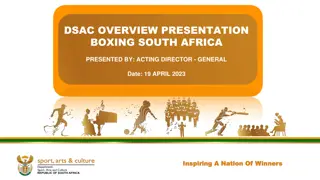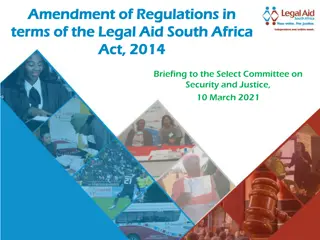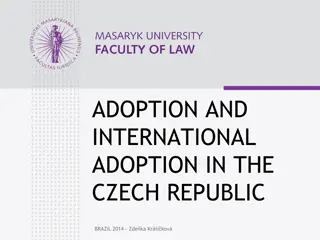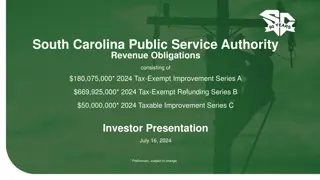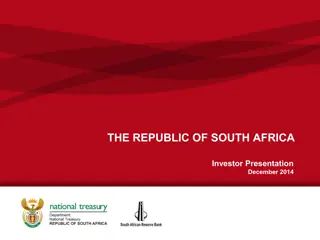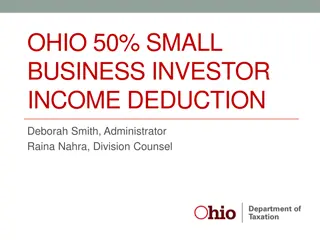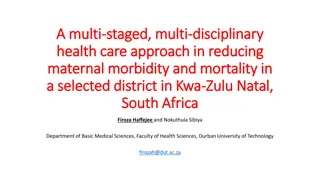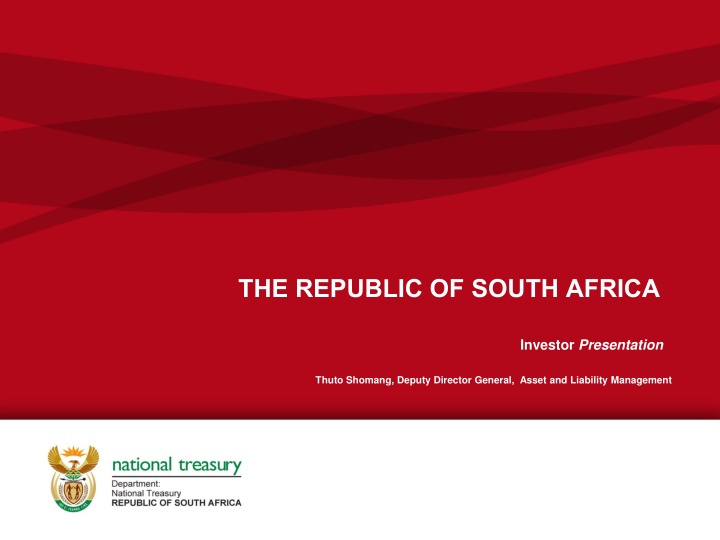
Investor Presentation: Republic of South Africa Economic Overview
This investor presentation delves into the macroeconomic developments, public finance, bond market trends, and more in the Republic of South Africa. Highlighting key themes and challenges in the economic environment, it discusses GDP growth projections, fiscal policies, and the impact of mining strikes on the economy. Explore insights on export performance, domestic supply constraints, and market variations across different destinations and industries.
Download Presentation

Please find below an Image/Link to download the presentation.
The content on the website is provided AS IS for your information and personal use only. It may not be sold, licensed, or shared on other websites without obtaining consent from the author. If you encounter any issues during the download, it is possible that the publisher has removed the file from their server.
You are allowed to download the files provided on this website for personal or commercial use, subject to the condition that they are used lawfully. All files are the property of their respective owners.
The content on the website is provided AS IS for your information and personal use only. It may not be sold, licensed, or shared on other websites without obtaining consent from the author.
E N D
Presentation Transcript
THE REPUBLIC OF SOUTH AFRICA Investor Presentation Thuto Shomang, Deputy Director General, Asset and Liability Management 1
Table of contents Slide 1) Macro Economic Developments4 2) Public Finance 9 3) Bond Market and Financing Trends 4) Holding of Government Bonds 23 14 2 2
Key highlights Broad themes economic environment uncertain and challenging GDP growth revised down and global risks to the outlook high domestic events highlight urgent need to accelerate social transformation supportive fiscal policy with disciplined spending and debt management Economic growth projected to be lower than the Budget forecast moderate GDP growth of 2.5% this year and 3.0% in 2013 economy supported by accommodative monetary and fiscal policies Budget deficit to moderate from 4.8% of GDP in 2012/13 to 3.1% in 2015/16 tax revenue revised slightly downwards by R5 billion in 2012/13 government debt is expected to peak at 39.2 per cent of GDP in 2015/16 Real growth in expenditure averages 2.9% over the MTEF total expenditure of R1.15 trillion in 2013/14 rising to R1.34 trillion in 2015/16 the 2013 MTEF reprioritises approximately R40 bn of funds 3 3
Mining strikes impacting negatively on the economy Violent and protracted strike action impacting negatively on investor confidence Production lost due to strikes in platinum and gold mining estimated at R10.1 billion Year to date mining stoppages subtracted an estimated 0.5 percentage point from GDP GDP growth for 2012 would have been 3% instead of the 2.5% the economy to created 38 500 fewer jobs in the mining, manufacturing and related services The total impact on tax revenue is estimated to be about R4.1 billion export revenues projected to be R12.5 billion lower in 2012 The negative impact on GDP growth in 2012 and 2013 will be larger if strike actions is protracted and spreads further to other mines and industries 5 5
Export performance varies across destinations and products Export volumes contracted 6.3% in the Q2 after falling 1.5% in the Q2 Annual growth in export values (first 8 months of 2012) Japan -20.7 Value of coal and chemicals exports robust while platinum (-21.9%) and base metals (-6.7%) declined European Union -4.0 United States 0.5 China 9.2 India 19.7 SADC 26.2 Domestic supply constraints exacerbated pressure on exports from weaker external demand Base metals -6.5 Precious & semi-precious metals -6.0 Vegetable products 7.5 Disruptions to platinum output affected trade with Germany, Japan and the US Other 11.0 Vehicles & transport equipment 12.3 Machinery and equipment SADC is our second largest export market with 21.8% share 14.3 Chemicals 16.3 Mineral products 19.6 led by steel, chemical products, and machinery and appliances, especially mining equipment. Total -40 -20 0 20 40 Source: Quantec 6 6
World viewpoint: Global growth outlook continue to deteriorate IMF growth and inflation projections, 2012 - 2014 Growth in advanced economy subdued by: high debt levels and banking sector crisis Growth slowdown in Brazil, China and India projected this year robust growth projected in 2013 and 2014 Unconventional monetary policy in advanced economies insufficient to: offset negative effects from front loaded fiscal consolidation and private sector deleveraging Euro debt crisis and US fiscal cliff significant global risks to growth outlook 7 7
The South African Story : The macroeconomic forecast Growth expected to be 2.5% this year before picking up to 4.1% in 2015 Public sector infrastructure investment to support growth in the MTEF Low inflation and interest rate to remain supportive to growth Inflation to remain within the target range of 3% 6% over MTEF Current account deficit widens to 5.9% this year before moderating to 5.5% in the outer years 8 8
Outcomes of the government fiscal framework Tax revenue for 2012/13 revised down by R5 billion resulting in higher deficit than Budget Expenditure remains contained, growing by 2.9% over the MTEF Debt costs projected to rise to R114.8 billion by 2015/16 Table 3.2 Consolidated fiscal framework, 2010/11 2015/16 2010/11 Outcome 757.4 27.5% 2011/12 2012/13 Estimate 900.6 27.5% 2013/14 Medium-term estimates 986.1 1 092.1 27.5% 2014/15 2015/16 R billion / percentage of GDP Revenue 837.0 27.7% 1 205.0 27.6% 27.6% Expenditure 874.4 31.8% 964.4 32.0% 1 057.1 32.3% 1 147.4 32.0% 1 238.1 31.3% 1 339.0 30.7% Non-interest expenditure 808.2 29.4% 887.9 29.4% 968.3 29.6% 1 048.8 29.2% 1 131.3 28.6% 1 224.2 28.0% State debt cost 66.2 2.4% 76.5 2.5% 88.8 2.7% 98.6 2.7% 106.8 2.7% 114.8 2.6% Budget balance -117.0 -4.3% -1.8% -127.4 -4.2% -1.7% -156.5 -4.8% -2.1% -161.3 -4.5% -1.7% -146.0 -3.7% -1.0% -134.0 -3.1% -0.4% Primary balance (percentage of GDP) Source: National Treasury 10 10
Trends in expenditure growth Real growth in non-interest expenditure Real growth of expenditure components Non-interest expenditure grew rapidly in the past decade but moderates over the MTEF Growth in the budget for compensation of employees will be contained Capital budgets grow strongly, the main challenge is to ensure that allocations are spent and spent effectively Source: National Treasury 11 11
The medium-term financing and debt levels Stock of government debt, 2005/06 2016/17 Government debt peaks at 39.2% of GDP in 2015/16 Domestic bond markets will remain the main funding source Debt issuance will be maintained at sustainable levels through drawing on cash balances exchanging debt maturing borrowing in global capital markets Public-sector borrowing requirement remains at 7.1 per cent of GDP expected to moderate in the medium term Source: National Treasury 12 12
Public-sector infrastructure investment Bulk of infrastructure spending to be financed from the balance sheets of SOCs Major infrastructure projects by phase and implementing agent Costs will be recovered by charges levied on users The fiscus will fund social and community infrastructure projects such as schools, health facilities and secondary roads Over the MTEF, R250 billion will finance shovel ready projects Other cost-effective projects that provide optimal long-term benefits will be eligible for support from the fiscus * Financed jointly by SOEs and government ** National, provincial and local government projects financed from the budget Source: National Treasury 13 13
National budget net borrowing requirement and financing, 2011/12 2015/16 2011/12 Outcome -147,962 5,209 -1,388 -144,141 18,725 19,009 2012/13 2013/14 Medium-term estimates -177,292 -165,776 4,400 -850 -173,742 -162,476 23,000 22,000 23,000 22,000 135,923 118,275 157,039 150,879 -21,116 -32,604 -3,553 11,610 11,535 25 -15,188 -7,834 2014/15 2015/16 Current debt issuance levels maintained by drawing on cash balances and switch programme R million Main budget balance Extraordinary receipts Extraordinary payments Borrowing requirement (-) Domestic short-term loans (net) Treasury bills Corporation for public deposits Domestic long-term loans (net) Market loans Redemptions1 Foreign loans (net) Market loans Arms procurement loan agreements Redemptions (including revaluation of loans)2 Change in cash and other balances3 Cash balances Other balances4 Financing 1. Domestic loan redemption figures are net of switches 2. Foreign loan redemptions in 2014/15 are net of anticipated switches 3. A positive change indicates a decrease in cash balances 4. Mainly surrenders of unspent money requested in previous financial years and late requests with regard to expenditure committed in previous years Budget -170,025 1,200 Revised -173,031 10,650 -3,152 -165,533 22,000 22,000 126,319 157,767 -31,448 -7,114 4,055 -11,352 -154,747 3,200 -151,547 21,000 21,000 117,115 144,755 -27,640 9,044 11,430 -2,386 3,300 -24 -168,849 22,000 22,000 119,998 151,367 -31,369 -7,492 4,035 -11,710 Domestic markets remain the primary source of financing -284 138,501 154,108 -15,607 9,135 12,025 -3,459 Foreign borrowing to maintain benchmarks in major currencies and partially finance government s foreign currency commitments 3,701 569 183 183 -22,219 -21,270 -949 144,141 34,343 30,743 3,600 168,849 24,328 15,828 8,500 165,533 18,372 13,872 4,500 173,742 18,500 14,000 4,500 162,476 4,388 -112 4,500 151,547 Domestic switch programme will continue and foreign switch programme introduced 15 15
Change in cash balances, 2011/12 2015/16 2011/12 2012/13 2013/14 2014/15 2015/16 R million Outcome Budget Revised Medium-term estimates Rand currency 111,413 19,037 130,450 129,425 -20,365 -109,060 130,450 -18,613 111,837 111,837 111,157 111,157 -14,000 97,157 97,157 97,157 Opening balance Cash utilised for domestic funding Closing balance Of which: Tax and loan accounts Sterilisation deposits Change in cash balance1 (opening less closing balance) Foreign currency2 Opening balance Domestic foreign exchange purchases3 International borrowing Cash utilised for foreign funding Closing balance US$ equivalent Change in cash balance1 (opening less closing balance) Total change in cash balances1 Total closing cash balance 1. A negative value indicates an increase in cash balances and a positive value indicates that cash is utilised to finance part of the borrowing requirement 2. Rand values at which foreign currency was purchased or borrowed 3. Foreign currency purchased in the spot market and obtained from the settlement of forward exchange contracts entered into by the South African Reserve Bank to sterilise sizable foreign direct investment flows -680 - 63,293 67,157 -19,037 41,903 67,157 20,365 44,680 67,157 18,613 44,000 67,157 680 30,000 67,157 14,000 30,000 67,157 - 64,376 19,488 4,238 -20,941 67,161 9,160 -2,785 11,635 -24,827 53,969 7,500 13,192 67,161 53,969 5,075 11,535 -16,610 53,969 7,500 11,430 -11,318 54,081 7,514 53,969 62,143 2,444 12,594 -12,805 64,376 8,804 -2,233 65,287 8,352 4,218 -22,948 54,909 7,624 10,378 - - - -112 -21,270 194,826 30,743 163,969 15,828 178,998 13,872 165,126 14,000 151,126 151,238 -112 16 16
Non-residents continue to support the local currency bond market Cumulative net purchases of bonds and equities , Jan 2010 Oct 2012 250,000 10.0 Cumulative net purchases of bonds by non-residents since 2010 amounts to R193 bn 9.5 200,000 9.0 R millions 150,000 per cent 8.5 100,000 8.0 7.5 50,000 7.0 Year-to-date net purchases of bonds totaled R83 bn surpassing net purchases of R42 bn recorded in 2011 since the WGBI announcement net purchases amounted to R59 bn 0 6.5 -50,000 6.0 Bonds Equities R208(6.75%,2021)[right aixs] Net purchases by non-residents per instrument , Jan 2012- Oct 2012 18,000 16,000 14,000 12,000 10,000 Net inflows by non-residents fairly spread across the yield curve R millions 8,000 6,000 4,000 2,000 0 -2,000 Source: JSE , Bloomberg , SA National Treasury 17 17
Falling borrowing costs despite high volatility Government borrowings costs continue to trend down falling by 70 basis points since April 2012 underpinned largely by strong demand from non-residents short-end of the yield curve anchored by accommodative monetary policy Fixed-rate bond yield curve 9.0 Apr-12 Sept-12 Oct -12 8.5 8.0 R2048 R214 R209 7.5 R213 per cent 7.0 R186 R2023 6.5 R207R208 6.0 5.5 R203 R204 5.0 R157 4.5 R206 R201 The yield curve remain steep due to issuance levels at the long-end of the curve interest rate cut speculations 4.0 0 5 10 15 20 25 30 35 Years Inflation-linked bond yield curve 2.5 Apr-12 Sep-12 Oct-12 Yields of inflation-linked bonds at historical lows rallying by 51 basis points since Apr 2012 (excluding the R189 bond) supported by robust demand from local Pension funds 2.0 1.5 I2050 I2038 R202 R210 1.0 Per cent I2025 R197 R212 0.5 R189 0.0 R211 0 4 9 11 12 16 21 25 38 -0.5 Years -1.0 18 18
Government bond auctions well subscribed Average bid to cover ratio of fixed rate bond auctions The fixed rate bond auctions over- subscribed the 14 year R186 has the highest subscription rates followed by 6 year area with subscription rates of 4 times 5.0 4.3 4.5 4.0 4.0 3.5 3.5 3.2 3.1 3.5 2.7 Per cent 2.6 2.6 3.0 2.5 2.0 1.5 1.0 0.5 0.0 On average, all fixed rate auctions cleared at the mark-to-market rates Average bid to cover of inflation linked bond auctions 5.0 Unprecedented subscription rates on inflation linked bonds the subscription rates in June and July were over 4 times the clearing levels were 2 basis points below the market-to-market rates 4.4 4.3 4.5 4.0 Per cent 3.5 3.1 3.1 3.0 2.5 2.0 1.8 2.0 1.3 1.5 1.0 Apr-12 May-12 Jun-12 Jul-12 Aug-12 Sep-12 Oct-12 19 19
Non-competitive auctions well taken-up Non-competitive actions performance per funding instrument 4500 Non-competitive auction an incentive to PD s 4000 3500 3000 2500 Year-to-date R15 bn was raised through non-competitive auctions Of which R4 bn was issued on the R2023 The 30 per cent limit increased to 50 per cent in August 2012 to accommodate anticipated inflows from WGBI inclusion R mllions 2000 1500 1000 500 0 Monthly take-up of non-competitive auctions 4500 4000 3500 In October 2012 R3.9 bn was raised through non-competitive auctions 3000 R millions 2500 2000 1500 1000 500 0 Apr-12 May-12 June-12 July-12 Aug-12 Sept-12 Oct-12 20 20
Refinancing risk in the medium term addressed through switch auctions Government debt maturity profile, as 25th October 2012 180,000 R12.3bn switched R22.1bn switched 150,000 120,000 R millions 90,000 60,000 30,000 0 Fixed rate bonds TB's Foreign bonds Inflation linked bond The plan is to switch R49 billion over the medium term R15 bn of R206(7.50%, Jan-2014) R34 bn of R201( 8.75%, Dec-2014) A remarkable progress has been made, R34.4 bn switched this fiscal year R12.3 bn switched from the R206 bond R22.1 bn switched from the R201 bond Source: SA National Treasury 21 21
Destination bonds for the switch auction programme Destination bonds of the R206(7.50%,2014) fixed rate bond Destination bonds of the R201(8.75%,2014) fixed rate bond R209, 2% R2023, 2% R186, 17% R208, 8% R213, 9% R214, 9% R157, 83% R186, 70% Appetite is mostly on the 3-legged bonds destination bonds R186 and R157 22 22
Non-residents holdings of government bonds continue to rise Holders of RSA government bonds as at Sept 2012 Holdings by non-residents tripled since 2007 reaching a record high of 33.3% in Sept 2012 Other, 2.3% Other financial, 6.5% Insurers, 10.3% Pension funds , 30.2% Non-residents confidence underpinned by history of prudent fiscal policy Monetary institutions , 17.4% Pensions funds holdings decline by 17.0 percentage points since 2007 Foreign investors, 33.3% Pension funds still buying bonds but the pace has subsided over the years Holders of domestic government bonds (%) , 2007 Sep 2012 2007 2008 2009 2010 2011 Sept-12 Pension funds 47.2 43.9 39.9 36.5 33.0 30.2 Holdings by Monetary institutions remained steady Foreign investors 10.6 12.8 13.8 21.8 29.1 33.3 Monetary institutions 16.5 18.0 18.3 17.7 16.3 17.4 Insurers holding declined marginally relative to 2007 levels Insurers 11.6 13.7 12.4 14.1 11.6 10.3 Other financial 12.2 10.2 13.2 8.1 8.0 6.5 Other 1.9 1.4 2.4 1.8 2.0 2.3 Source: Share Transaction Totally Electronic LTD(Strate) 24 24
Holdings of fixed-rate government bonds Holdings of fixed-rate bonds by sector, Sept 2012 Non-residents hold largest portion of fixed-rate bonds accounting for 40% Other financial institutions, 6% Other sector , 3% Official pension funds , 21% Foreign sector, 40% Holdings of fixed-rate bonds by non- residents is fairly spread across the curve non-residents also buying at the back end of the yield curve holding 35% of the 28-year and 26% of 35-year bonds Private self- administered funds, 3% Short-term insures, 1% Long-term insures, 10% Monetary authorities, 16% Holdings of fixed-rate bonds by maturity area 120% 100% Official pension funds underweight in the 24-year to 35-year area 80% 60% 40% 20% Local long-term issuers overweight at the long end of the curve 0% Foreign sector Long-term insures Private self-administered funds Other financial institutions Monetary authorities Short-term insures Official pension funds Other sector Source: STRATE, SA National Treasury 25 25
Holdings of inflation-linked government bonds Holdings of inflation-linked bonds , Sep 2012 Inflation linked bonds dominated by pension funds and monetary institutions accounting for combined share of 80 per cent Pension funds hold linkers to protect assets against rising inflation Banks hold linkers to replicate their inflation-linked liabilities Other financial institutions, 8.7% Other sector , 0.4% Foreign sector, 5.3% Monetary authorities, 24.2% Long-term insures, 5.2% Official pension funds , 39.0% Short-term insures, 0.6% Private self- administered funds, 16.6% Non-residents starting to buy inflation linked bonds non-residents now hold 5.3 per cent of Inflation linked bonds Holdings of inflation-linked bonds by maturity area 120% 100% 80% 60% 40% Pension funds holding fairly spread all across maturities 20% 0% Foreign sector Long-term insures Private self-administered funds Other financial institutions Monetary authorities Short-term insures Official pension funds Other sector Source: STRATE, SA National Treasury 26 26
Retail bonds growing in significance Age distribution of retail bonds investor base,31 March 2012 The number of retail investors has grown by 15% to 44 163 from March 2011 to March 2012 Investments average R4 bn a year Current investments at over R11 bn Gender distribution of retail bonds investor base,31 March 2012 Investors aged 50 years and older invest most 54% The current market strategy is to diversify the investor base and attract investors younger than 50 years 46% In terms of gender, the female investors surpass the male investors Female Male Source: National Treasury 27 27
Conclusion Global Economic environment uncertain and challenging Fiscal and monetary policies supportive of economic growth Government committed to fiscal consolidation in the MTEF Quick resolution of the labour unrest in the mining sector imperative Non-residents continue to support the local currency bond market The R49 billion switch program to continue in the MTEF 28 28

